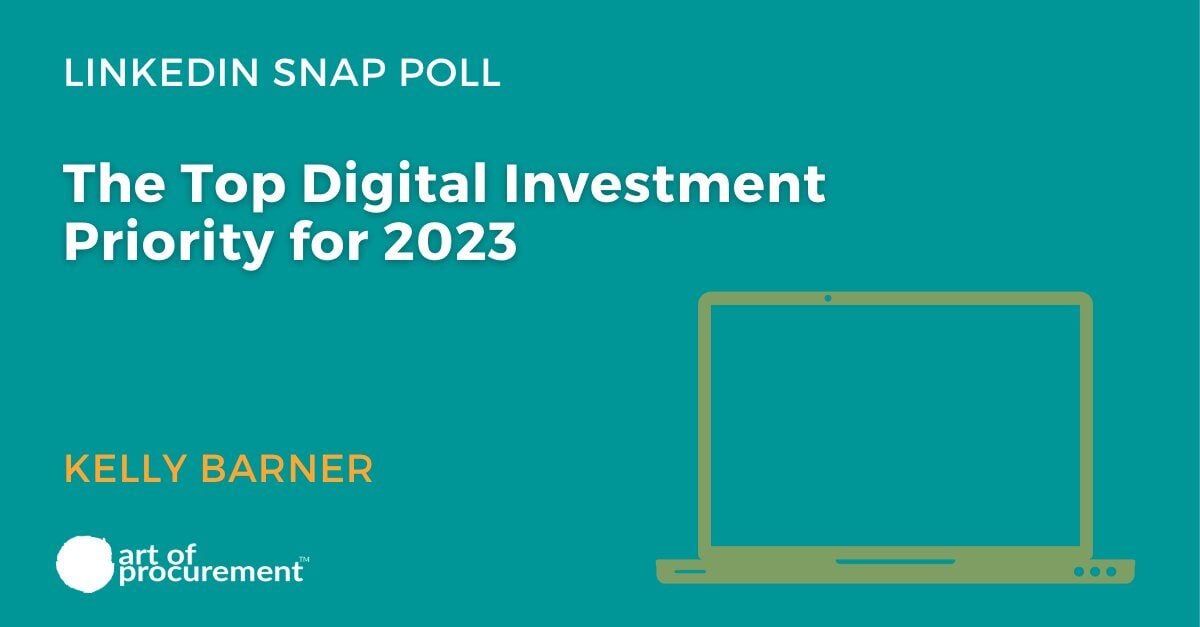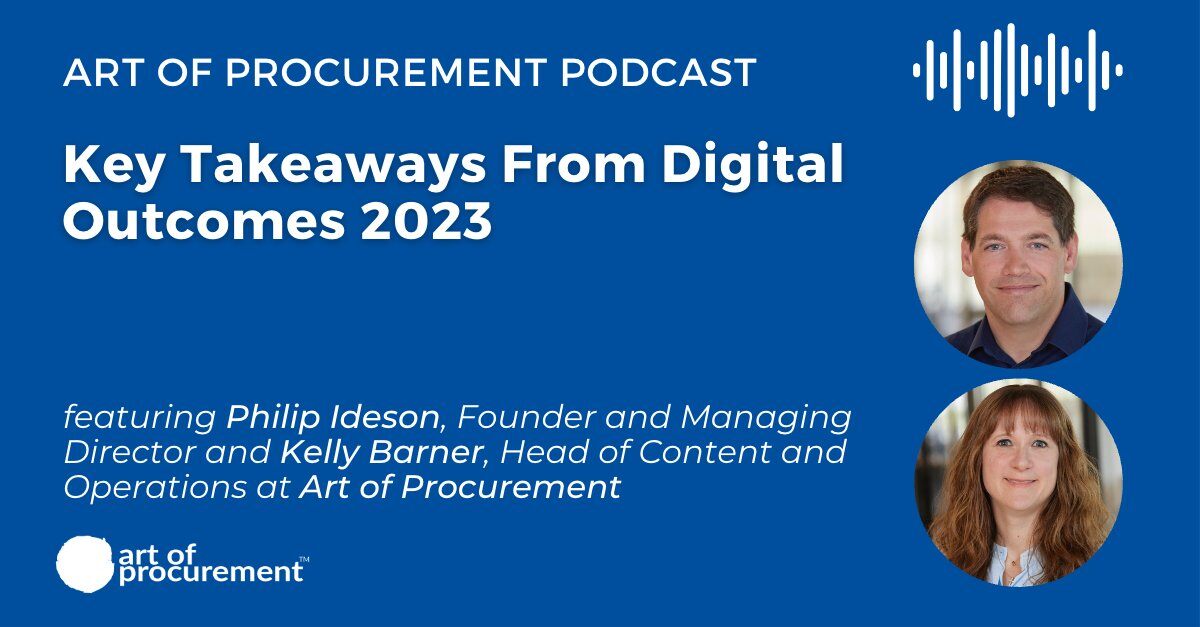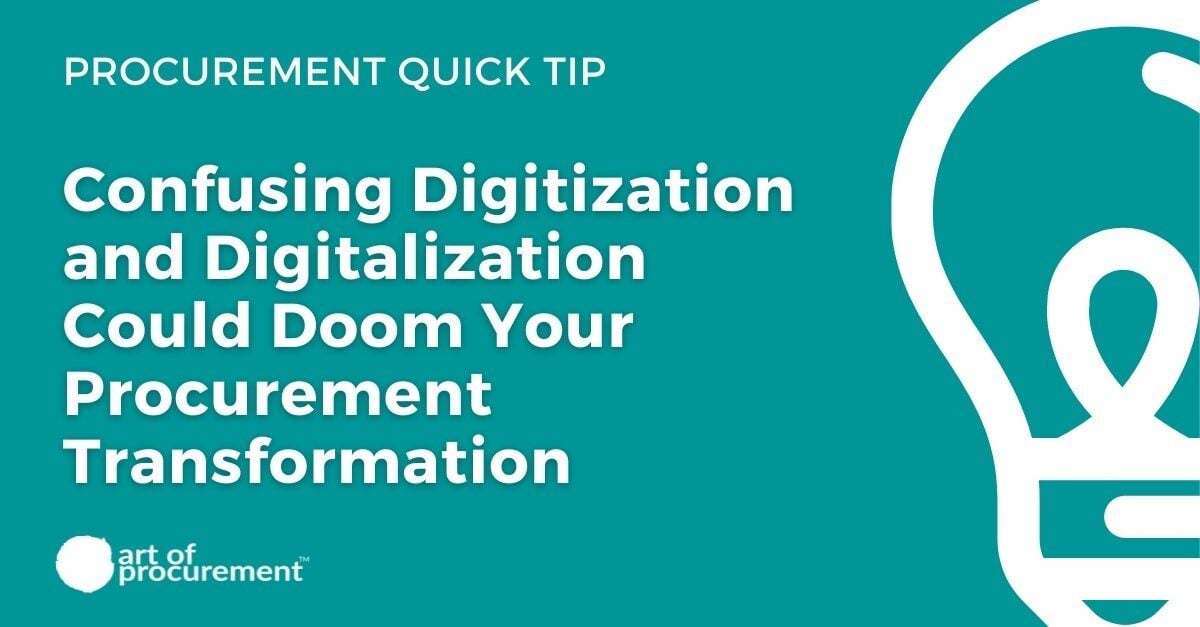
In this week’s episode of the Art of Procurement podcast, Philip Ideson and I took some time out to give the listening audience a sneak peek at the speakers and sessions that will be featured at Digital Outcomes 2023, our first thematic virtual event of the year, which is being held on February 15th and 16th from 10am – 1pm ET.
As we always do, we had a little fun and went a little off script, taking the opportunity to share the reasons behind our belief that procurement needs an event that goes beyond digital features and functionality, and instead focuses on measurable business impact and tangible digital outcomes.
Listen to Digital Outcomes 2023 Agenda Reveal w/ Kelly Barner and Philip Ideson
All too often, procurement invests in technology and then two or three years down the line everyone is looking for the ROI they expected – wondering where it went and why the technology didn’t have the impact they wanted. Digital procurement may be table stakes, but that doesn’t mean it automatically translates to value. At Digital Outcomes, we will explore a number of angles on this challenge.
Prioritizing the Digital Procurement Experience
Jaime Gracia leads a team at the U.S. Department of State that is delivering a ‘next level’ procurement user experience. They have completely redesigned the way procurement works so that it serves their users – even within the strict requirements of the Federal government.
From our own polling, we know that the number one priority for digital procurement investment in 2023 is improving the user experience. Procurement is finally embracing the idea that they can’t win if users don’t win first. Going back to the point about ROI that fails to materialize, there are no benefits from functionality if a critical mass of people don’t adopt a solution. Period.
Users expect to be able to use a platform and figure it out on their own with no training. If they don’t use it again for six months, it should still feel familiar when they return. That doesn’t happen by accident, and Jaime and his team have figured out how to create and maintain just those conditions.

Harnessing the Power of Digital Pilots
Matthias Gutzmann, Founder of DPW (Digital Procurement World), helps organizations scout for emerging tech providers that solve unique challenges. As exciting as the explosion of procurement tech startups is, it also makes it harder for procurement to decide who to shortlist and who to partner with.
Even once a decision has been made, many procurement teams don’t know how to manage digital pilot programs. Calling a project a pilot doesn’t make it lower risk or less work. In fact, there may be additional effort required when procurement takes the road less traveled.
As more and more procurement teams are looking at making small investments, demonstrating ROI quickly, and then using that demonstration of ROI to secure additional investment, the ability to run successful pilot programs becomes a huge part of building a tech stack. Given today’s constrained budgets, every single dollar has to be placed strategically.
Cloudy with a Chance of Cyber Risk
Procurement’s typical response to cyber risk is taking an RFP questionnaire developed by IT or the Information Security team, inserting it in every event, and passing supplier responses along for them to approve. But with ever increasing supplier digitization, that may not be good enough.
Jo Peterson is a cybersecurity expert accustomed to speaking to non-IT professionals about cyber risk decisions and business implications. Her goal isn’t to turn procurement into cyber experts overnight, but rather to provide the context and language required to facilitate better conversations.
Procurement needs to be educated enough to ask suppliers specific questions and to indicate the level of sophistication expected in their answers. The same is true for conversations with IT, finance, and other internal stakeholder groups.
Top Performance Concerns for Forward Looking Executives
Procurement has to be able to demonstrate the outcomes they drive for the business on a day-to-day basis. Stakeholders should see the value in working with procurement, but oftentimes that gets lost or fails to scale beyond individual stakeholder relationships.
If the goal is to help procurement succeed in 2023 and beyond, the first step is to define what success looks like and how it will be measured. Although metrics like savings and spend under management are not going away, they pale in comparison to the actual responsibilities and contributions associated with procurement over the course of the year. The goal should not be replacing them so much as it is adding to them so that procurement’s performance metrics and definitions of success are as robust and broad as the work they do.
Blessen Kurian, Procurement Director, Digital & Data Science at Thermo Fisher, and Keith Barthelmeus, Global VP and CFO of Product and Technology at Brinks, will join Pierre Laprée from SpendHQ in this session to talk about different functional perspectives on procurement success.
The Care and Feeding of the Procurement Startup Ecosystem
Jack Freeman, a Partner at PeakSpan Capital, has been a regular speaker at Art of Procurement events and a guest on the podcast. He has a unique perspective on what the procurement technology space looks like from an investor’s point of view.
One of the most interesting things he will address in this session is the pace of change in the tech space compared to the typical level of experimentation among CPOs.
Innovators and early adopters may jump at new platforms, but they don’t necessarily represent the interests of the market as a whole, which is what a startup needs to access if they are going to grow their presence. It is the mass market that determines their potential for longer term existence and success. But is the procurement mass market ready for what they offer?
Thriving in the Chasm
Phil and I are running a session of our own at Digital Outcomes this year to talk about the maturity journey associated with the adoption of procurement technology, but also the embrace of procurement as an advanced, technology-enabled function.
Crossing the Chasm by Geoffrey A. Moore wasn’t written specifically for procurement. As a result, the model is validating for procurement because it means that procurement faces the same challenges as everyone else when it comes to managing change.
In all human communities, there are innovators and early adopters. Ideas and technologies either cross the chasm or they don’t. Procurement isn’t facing these hurdles because they are falling short in some way. They are simply human – just like everybody else, including users.
For more procurement thought leadership, subscribe to the Art of Procurement podcast!




